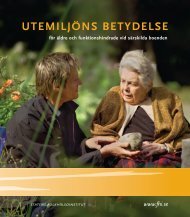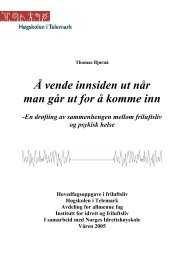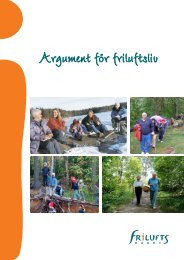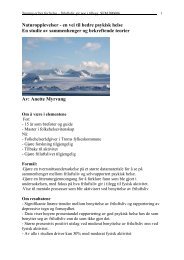Green Care: A Conceptual Framework - Frisk i naturen
Green Care: A Conceptual Framework - Frisk i naturen
Green Care: A Conceptual Framework - Frisk i naturen
Create successful ePaper yourself
Turn your PDF publications into a flip-book with our unique Google optimized e-Paper software.
5.3.5 Food production in rural areas: community<br />
supported agriculture and box schemes<br />
Another model of food production relevant to green care is that of<br />
community supported agriculture or CSA. Community-supported<br />
agriculture (also known as “community sponsored agriculture”) is a<br />
relatively new socio-economic model of food production, sales, and<br />
distribution aimed at both increasing the quality of food while substantially<br />
reducing potential food losses and financial risks for the producers. Over<br />
the last 20 years in the US and Canada, CSA has become a popular way<br />
for consumers to buy local, seasonal food directly from a farmer, with<br />
over 1000 CSAs in existence (Pretty, 2002). Typically a farmer offers a<br />
certain number of ‘shares’ to the public and these usually consist of a box<br />
of vegetables (but other farm products such as meat, flowers herbs etc. may<br />
be included). Interested consumers purchase a share and in return receive<br />
a box (bag, basket) of seasonal produce weekly throughout the farming<br />
season.<br />
Like many green care programmes, CSA operates with a much greaterthan-usual<br />
degree of involvement of consumers and other stakeholders,<br />
which results in a stronger than usual consumer-producer relationship. The<br />
core design includes developing a cohesive consumer group that is willing<br />
to fund a whole season’s budget in order to get quality foods.<br />
In the UK, box schemes outnumber CSAs. These schemes began in the<br />
early 1990s and now over 550 schemes supply households weekly. Farmers<br />
contract to supply basic vegetables and add other produce depending on the<br />
season. Over time, box schemes also increase on-farm biodiversity as in<br />
response to consumer demand, many farmers have increased the diversity<br />
of crops grown.<br />
A central rationale for both CSAs and box schemes is that they emphasise<br />
that payment is not just for the food, but for support of the farm as a whole.<br />
It is the linkage between farmer and consumer that guarantees the quality of<br />
the food. This encourages social responsibility, increases the understanding<br />
of farming issues amongst consumers, and results in greater diversity in<br />
the farmed landscape (Pretty, 2002). Many of these farms either already<br />
provide green care services in conjunction with food production or are<br />
often ideally suited to do so as they employ more people per hectare, and<br />
provide livelihoods on a much smaller area than conventional farming.<br />
66 <strong>Green</strong> <strong>Care</strong>: A <strong>Conceptual</strong> <strong>Framework</strong>















